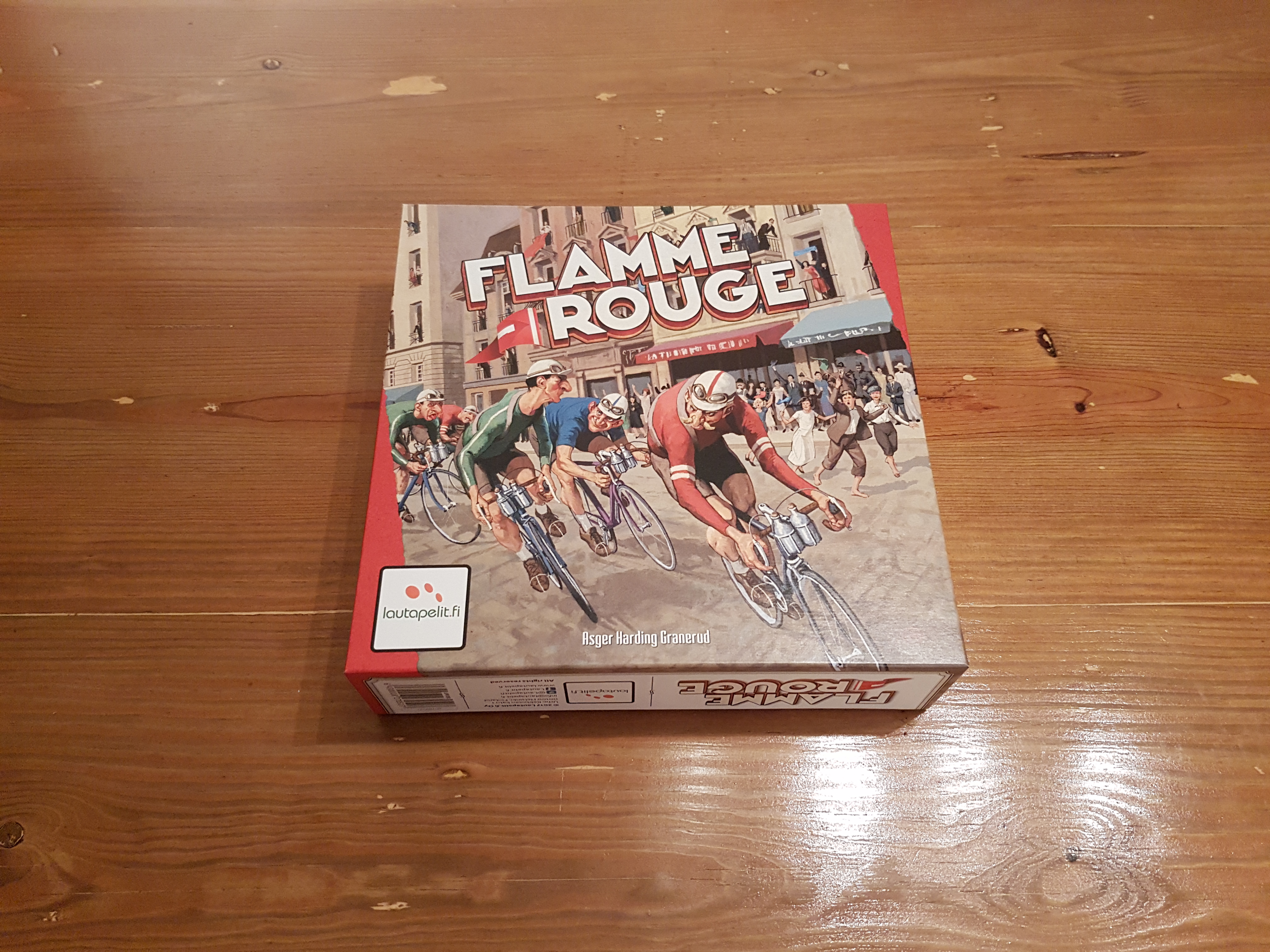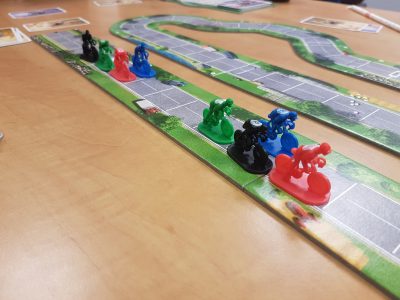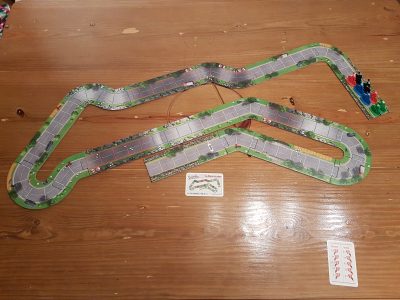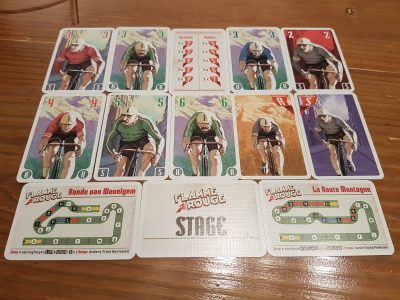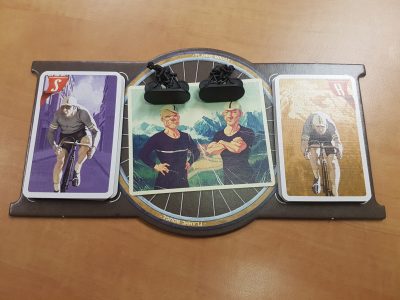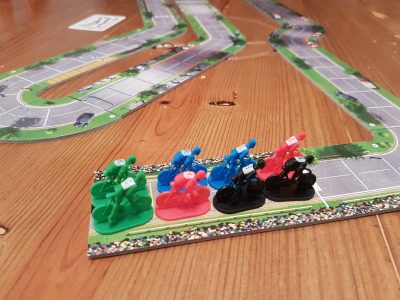Flamme Rouge is a board game built around the concept of a tactical bicycle race. Designed by Asger Harding Granerud the game is fairly light on rules and is built for 2 – 4 players. Players will have to handle jostling for position, exhaustion and other racing mechanisms. Each player controls a team of two riders ready to pedal to victory. Yet, is this a victorious gem of a game or is it as flat as a puncture? Let’s find out.
Each team of two trusty cyclists is identical: made up of a Rouleur and a Sprinteur. The major difference is the minimum and maximum number of spaces they could potentially move on a turn. Each turn players will take the top four cards from either of their riders’ decks. Of these four cards players choose one to play, placing the rest into a discard pile. Players then repeat this process for their second rider before everyone reveals both selected cards. For the Rouleur the values on the cards range from 3 to 7, while the Sprinteur’s range from 2 to 9.
After the cards have been unveiled the cyclist pieces are moved in order from front to back. Let’s look at an example of if the Red Rouleur cyclist is in the lead. If the red player has played a card with value 4 for their Rouleur it is first to move and goes forward 4 spaces. Each space has two lanes, though it doesn’t matter which lane you’re in. If you are the first player to end on a square you are automatically moved to the right lane, with anyone else landing on that square afterwards put in the left lane. So, following on the example the Red Rouleur would have moved four and ended in the right lane. Cyclists can move through a space with two riders on it but not end on that space. If a third racer tries to end on the same space they fall back to the space behind it.
Once all the cyclists have moved it is time to see whom is in a slipstream position and whom will get exhausted. Starting from the back of the field if any pack of riders has one and only one free space between them and the pack in front they get to slipstream. This sees the pack move forward one closing the gap. This continues up the packs of riders to the front of the field, potentially seeing some riders slipstreaming multiple times. If a rider doesn’t have anyone in front of them or has a gap bigger than 1 space they don’t get to move. Slipstreaming is a key mechanic to understand as it can help players catch up, or just move free spaces throughout the race.
Next is exhaustion, any rider at the front of a pack of cyclists, now takes an exhaustion card. These are cards with a value of two which are placed into the player’s Rouleur or Sprinteur discard pile accordingly. These low valued cards can clog up your hand when you want to play bigger numbers and gain a lead on the opposition. Played cards are discarded from the game and then the next round begins. Whenever a draw pile is depleted shuffle the discard pile, including any exhaustion cards earnt, to make a new draw pile and continue as usual. Exhaustion can cost you a race but it is all about playing the odds of what cards you’ll draw.
Being a round based game it would be harsh to be whomever crosses the line first wins. Instead, when a rider crosses the line that round is the final turn. Everyone moves as usual and if only one player ends up over the finish line they win. If more than one player crosses the line it is how far past the line they end up that determines who wins.
Mathematically every player has enough cards to get comfortably get across the finish line. it is when players decide to utilize their high valued cards which will see where they come in the race. After the basic race on Avenue Corsa Paseo hills get added into the mix to spice up the game. When peddling uphill the maximum value of a card is reduced to 5, no matter the card, and slipstreaming doesn’t occur. The opposite is the case when zooming downhill as the minimum value is increased to 5. Play even a two-valued exhaustion card on a downhill stretch and reap the rewards of the hill, just be careful positioning wise moving into these areas as bunching can easily occur.
These locations on the track can be focal points for conflict and jostling for position. As players struggle to get into the perfect position coming up to a hill it can end up resulting in a traffic jam uphill. This can allow those otherwise left behind to catch up, a neat track based catch up mechanic. One that works within the mechanics of the game and make sense thematically. This is something which is consistent throughout Flamme Rouge. The game feels like you’re taking part in a cycling race. Partially due to controlling two riders you get a sense of it being a team sport. Combining this with the way packs split off, jostling for position is so key and being in first for most of the race is detrimental it is like a race is unfolding before your eyes.
Flamme Rouge hints at being a hand management game as you can look to burn your big hitting cards early to pull away from most of the other riders or look to hold onto them for as long as dare. With a total of 190 cards included in the box, broken down into 120 Energy Cards and 60 Exhaustion cards, there certainly is enough to be a card game. These sets of cards are the further broken down into coloured sets for the players, and then by Rouleur and Sprinteur. Be warned there is a lot of shuffling of these cards as the game progresses. Unlike most games the frequency of the shuffling only increases throughout the game as cards are removed from the game, reducing the size of players’ draw piles.
In Flamme Rouge there are 6 suggested stages to race on. Playing on these tracks shows off the way players can construct tracks, an element that the game really excels at. The track is a rather important component of a cycling race, so it’s good that thought has been put into this aspect. The little details alongside the track such as crowds of supporters, loose sheep and pulled over cars all help set the mood for the game. Unlike a lot of racing games designed on a board Flamme Rouge comes with track pieces to add together in differing ways to form tracks. The track is very modular which shouts out to me three things: replayability, customisation and expansions.
The first two very much go hand in hand as players can customise tracks. The modular clip together design allows players to easily chop and change bits around to make different racecourses. While corners don’t do too much, where hills are placed and their frequency can completely change a track. This instils a replayability into the game that wouldn’t be present from a singular solid board. Even if it was to be double sided like Downforce.
The last word expansion was instantly in my mind before even consulting Board Game Geek to find there is an expansion releasing this year – Flamme Rouge: Peloton. All it would take for future content would be to include differing track pieces that slot into the modular system and there you have even more variability. That is exactly what Peloton will do among other things. It is almost like the modular track decision was made to open this potential up.
One component issue I would point out is the Sprinteurs are not properly attached to their bikes. This adds an awkwardness to moving them, something that can happen multiple times a round from movement and slipstreaming. This fiddly-ness makes me worry about the fragility of these pieces and if they will survive the game consistently hitting the table. A spot of glue is enough to fix the issue but should this really be something in a game costing over £30. Absolutely not, and for that matter it shouldn’t happen regardless of the price. When this actively effected the enjoyment of the game for some players, as they were scared to touch the cyclists, it may be small but becomes noteworthy.
This is far from golf but the rules do include a quick optional Handicap rule to help out when new player join in the fun. This targets experienced players by adding an exhaustion card into their decks at the offset of the game. This slightly shifts the ratio of bad cards in the experienced players deck, leaving the new players to get to grips with the game. It is also worth start off playing on the Avenue Corsa Paseo course as this does not include hill sections. Hills don’t change too much but playing a flat track means two less rules for players to learn. At the same time, there are only a handful of rules to learn in total so Flamme Rouge is extremely welcoming to new players.
The player pieces should be instantly recognisable, the Sprinter is in a more standing position while the Rouleur is hunched over the handlebars. To make it more obvious they have letters, S & R, on the back of their jerseys. Yet, it is surprisingly easy to get the two a little confused. Depending on the angle and distance from the track there is often a lot of leaning in and over the track to determine which rider is which. As an extension to this it is easier if one player moves all the riders rather than different people doing it and it’s always more fun to move your own pieces.
When you think of transportation based sports not many minds jump past driving fast cars to cycling. However, Flamme Rouge is here to change that, at least in a board gaming sense. Flamme Rouge is more of a card management to get into first place, fighting for position rather than a straight race. It feels very back and forth with the leader changing constantly throughout the race. The middle of the race has a little lull in the action. Nevertheless, the splitting off at the start and the frantic dashes at the end to get across the finish line is more than worth the turn or two of slowness in the middle. Flamme Rouge takes what is a team based sport and makes those concepts transcend into a board game. It might be hard to get players excited from the theme alone but once they have played they’ll want to race again!
[Editor’s Note: Flamme Rouge was provided to us by Esdevium Games for review purposes. The game is currently available on 365 Games for £32.99. It is also available from local UK board game stores, find your local store here]

